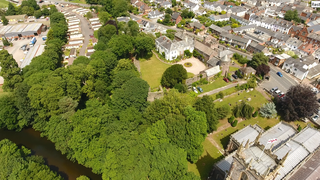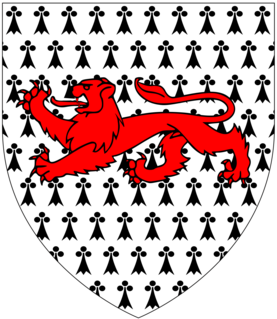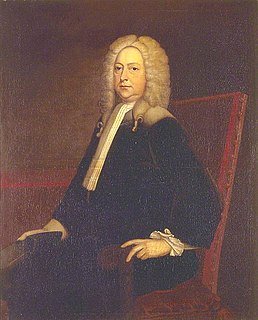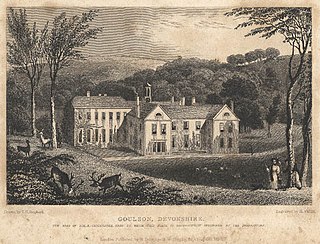Related Research Articles

Sir Hugh Acland, 5th Baronet was an English Member of Parliament, from a family of Devonshire gentry. He obtained a confirmation of the family baronetcy in 1678, and served as a Member of Parliament for two boroughs in Devon in 1679 and from 1685 to 1687. Never very active in national politics, he was one of the many Tories estranged by James II's pro-Catholicism, but remained a Tory after the Glorious Revolution. He continued to hold local office in Devon off and on until his death in 1714, when he was succeeded by his grandson.

Cruwys Morchard is an ecclesiastical and civil parish in the Mid Devon district of the county of Devon in England. It is located about four to five miles west of Tiverton along the road to Witheridge. The parish covers about 5,765 acres (23.33 km2) of land, and comprises a number of scattered houses and farms, and three small hamlets, Pennymoor, Way Village and Nomansland. The church and the manor house are in the centre of the parish. The population at the time of the 2000 census was 461. The parish takes its name from the Cruwys family who have been Lords of the Manor here since the reign of King John (1199–1216).
Margaret Campbell Speke Cruwys née Abercrombie was an archivist and Devon historian. She was born in Ayr, Ayrshire, Scotland, and was the daughter of Alexander Houghton Abercrombie, an officer in the 21st Royal Scots Fusiliers. She married Lewis George Cruwys of Cruwys Morchard, Devon, on 19 November 1917 at St David's Church, Exeter. She became a member of the Devonshire Association in 1931 and was elected President in 1952. She was a member of the Devon and Exeter Institution, serving first as their secretary and then as president. Cruwys was editor of Devon and Cornwall Notes and Queries for thirty years. She was awarded a Fellowship of the Society of Antiquaries of London in 1950 for the work she did indexing and cataloguing the large collection of family papers held at Cruwys Morchard House. She died on 12 March 1968 at 31 St Peter Street, Tiverton, Devon, and was buried on 18 March 1968 at the Church of the Holy Cross, Cruwys Morchard, Devon.

Tiverton Castle is the remains of a medieval castle dismantled after the Civil War and thereafter converted in the 17th century into a country house. It occupies a defensive position above the banks of the River Exe at Tiverton in Devon.

Robert Geoffrey Cruwys was an English cricketer and clergyman. He was born in the family manor, Cruwys Morchard House, located in Cruwys Morchard, a small parish in Devon which takes the name from the Cruwys family who have been Lords of the Manor here since the reign of King John (1199–1216).
Edward Eliot was an English politician who sat in the House of Commons between 1660 and 1679.
Robert Shapcote was an English lawyer from Devon and four times Member of Parliament for Tiverton in 1646–1649, 1654, 1656 and 1660. He sat in the Irish House of Commons for Wicklow Borough from 1661 to 1665 and was briefly Attorney-General for Ireland. He fought in the Parliamentary army in the Civil War.

Sir John Davie, 1st Baronet (1588–1654) of Creedy in the parish of Sandford, near Crediton, Devon, was a member of the Devonshire gentry and served as Member of Parliament for Tiverton in 1621-2 and as Sheriff of Devon (1629–1630). He was created a baronet in 1641.
Henry Newte the younger was an English politician who sat in the House of Commons in 1660.

Sir Thomas Stucley of Affeton Castle, Devon was an English landowner and politician who sat in the House of Commons from 1661 to 1663. He fought in the Royalist army in the English Civil War.

Edward Colman (c.1734–1815) was an English army officer, politician and official.

Duvale is a historic estate in the parish of Bampton, Devon. It is situated on a narrow flat plain in the steep-sided valley of the River Exe, 1 1/2 miles south west of the town of Bampton and 5 miles north of Tiverton, also on the River Exe further downstream. The name, given by Pole (d.1635) as Deu Vale, is said by him to signify "a valley of water". It was until the nearby construction of the present busy A396 road a place of exceptional seclusion and tranquility.

Sharpham is an historic estate in the parish of Ashprington, Devon. The Georgian mansion house, known as Sharpham House, overlooks the River Dart and is a Grade I listed building. The house was commenced in about 1770 by the Royal Navy captain Philemon Pownoll to the designs of the architect Sir Robert Taylor (1714–1788). In the opinion of Nikolaus Pevsner it contains "one of the most spectacular and daring later 18th century staircase designs anywhere in England". The park and gardens are Grade II* listed in the National Register of Historic Parks and Gardens. Part of the descent of Sharpham is shown on the Palmes family heraldic pedigree roll.

Sir Hugh Stucley (1496–1559) was lord of the manor of Affeton in Devon, and was Sheriff of Devon in 1545. His third son was Thomas Stukley, known as "The Lusty Stucley".

The Drewe family of Broadhembury were for many generations owners and inhabitants of The Grange, Broadhembury, Devon, in the west of England, from the 16th to 19th centuries.

Lyneham in the parish of Yealmpton in Devon, is an historic estate. The surviving grand mansion house known as Lyneham House is a grade I listed building. It was built c.1699-1703 by Sir Courtenay Croker, MP for Plympton Morice in 1699. A drawing of Lyneham House dated 1716 by Edmund Prideaux (1693–1745) of Prideaux Place, Padstow, Cornwall, survives at Prideaux Place. It shows formal gardens in front with flanking pavilions and an orangery.
The manor of Hillersdon was a historic manor in the parish of Cullompton, Devon, England which was held by the de Hillersdon family from the 13th century until the early 16th century. It was then held by a number of different families including the Cockeram, Cruwys and Grant families. Hillersdon House was built in the nineteenth century by the Grant family and is still in use.

Francis Drewe, of the Grange, Broadhembury, Devon, was a British lawyer and Tory politician who sat in the House of Commons from 1713 to 1734.

Sir Arthur Chichester, 3rd Baronet (1689–1718), of Youlston Park, Devon was an English landowner and politician who sat in the House of Commons in two periods between 1685 and 1718.
References
| Parliament of England | ||
|---|---|---|
| Preceded by Robert Shapcote Thomas Bampfylde | Member of Parliament for Tiverton 1660 With: Robert Shapcote | Succeeded by Henry Newte Robert Shapcote |
| This article about a British politician is a stub. You can help Wikipedia by expanding it. |